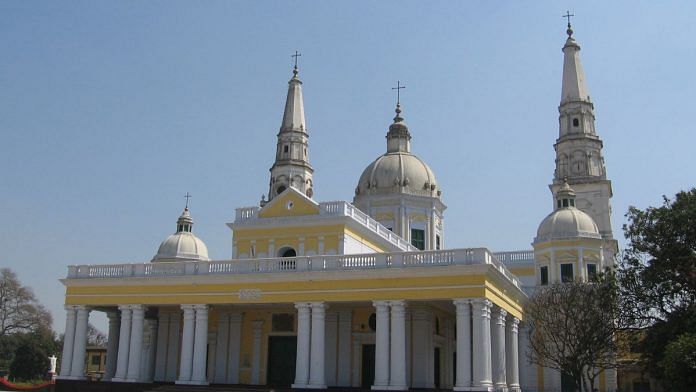An old church near Meerut became part of a lively discussion at Delhi’s Indian International Centre this week about architecture, history and gender roles in the 19th century. At the heart of this discussion was Begum Samru.
The late 18th century in India was a time of not only tumultuous changes but also one of opportunities to re-invent identities. And Begum Samru epitomised this re-invention. She lived through a time of great political and cultural changes in northern India – and went on from being a Muslim dancing woman to a Catholic convert to the ruler of Sardhana to a Jagir and commanding armies like an Indian Joan of Arc. National Geographic called her a ‘power broker’.
Recently, a scholar in Delhi also credited her with ‘architectural adventurism.’
At a packed seminar at Indian International Centre (IIC), Jyoti Pandey Sharma, a professor at the School of Planning and Architecture, presented her illustrated findings of how Begum Samru inhabited a time of politically fluid and culturally hybrid identities. The central showpiece of Samru’s fluidity was a unique church she built in Meerut in 1822 with white Islamic domes.
“It epitomised Begum Samru’s feisty spirit and her quest to be counted as a champion of the Catholic faith in the subcontinent in a largely Protestant religious landscape and shaped her legacy for posterity,” said Sharma.
But other scholars present at the event disagreed and claimed that the church wasn’t unique and that there are many built structures during that period that reflected a coming together of cultural influences.
Also read: An ‘ambitious’ courtesan & a British officer — the tale behind Old Delhi’s Mubarak Masjid
Sardhana Church: Begum Samru’s legacy
One unique feature of the church is the tomb, which is believed to be incorporated from the Mughal century. According to Sharma, there are architectural similarities between Claude Martin’s Constantia (Lucknow), David Ochterlony’s Mubarak Bagh (Delhi) and the Sardhana Church.
Commenting on the hybrid architecture of the church, Sharma said, “The ensuing camaraderie between military adventurers and Indian rulers produced an entanglement of cultures that impacted the built environment. This resultant spatial and stylistic hybridity went beyond fulfilling spatial needs to become a tool of identity assertion.”
It is believed that the hybrid nature of the church reflects Begum Samru’s life and the way she broke stereotypes.
Sharma quoted European writer Anna Deane, who also visited the Sardhana church, “The Begum adhered to the Mohammedan way of living as far as food was concerned, but no further; indeed, she had no taste for the seclusion Easterns imposed on their women, but on the contrary was in the habit of giving sumptuous banquets to English officers and residents.”
In 1767, Begum Samru was noticed by a German military adventurer, Walter Reinhardt. Following Reinhardt’s death in 1778, she became the ruler of his Jagir, Sardhana. Begum embodied the duality that came with the East-West cultural entanglement. She adopted European mores that were showcased in public as she entertained several Governors and Commanders of the East India Company.
As a ruler, Begum’s personal and professional skills kept her in the good books of both the Mughal ruler in Delhi and the British East India Company, which marks her significance for linking western culture with Indian culture.
Refuting Begum’s uniqueness, Indian historian Madhavan K Palat said, “In History, there have been a lot of women rulers, politicians who are patrons of art. So, it doesn’t make Samru any exceptional just because she was a Muslim women converted into Catholicism. It was British commentators who portrayed her exceptional, as in Britain there are no such women, but India has. Indian writers might not find her so exceptional as she doesn’t fit the tradition.”
He also added that the term ‘adventurism’ is a bit pejorative. He said, “It is more eclectic than adventure.”
A monumental 18-feet-tall sculpture depicting the Begum being surrounded by European and Indian courtiers is the centrepiece of the Sardhana Church. From being the only Catholic queen of Indian history to being remembered as feminist icon of the 18th century, Begum Samru has left her legacy in the church. And numerous people still travel great distances to visit there.
As far as Professor Sharma’s seminar on Architectural Adventurism is concerned, an architect AGK Menon, says, “Nothing is pure, everything is hybrid. These findings are certainly not enough to prove this church is particularly hybrid.”
(Edited by Ratan Priya)



